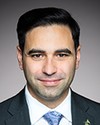There are two questions there. I'll try to answer both very quickly.
We're located in British Columbia. We are Canada's Digital Technology Supercluster. We have now received submissions from across the country, from Atlantic Canada, Montreal, Ontario, the Prairies and B.C. We have a strong reach.
When we talk about broadband access, it is an issue that affects British Columbia as well as other provinces, and it does impact the ability of small and medium-sized enterprises to grow in rural communities.
It also impacts something else that we're focused on. In the superclusters, in ours, we are very much focused on developing an effective, diverse, digitally trained talent pool. We talk a lot about digital training, and training for people in remote, rural and indigenous communities. If you can't get on the Internet, then you can't access that training. Advancing and exploring ways to accelerate access to broadband is really important, and we are actually looking at that right now for British Columbia.




